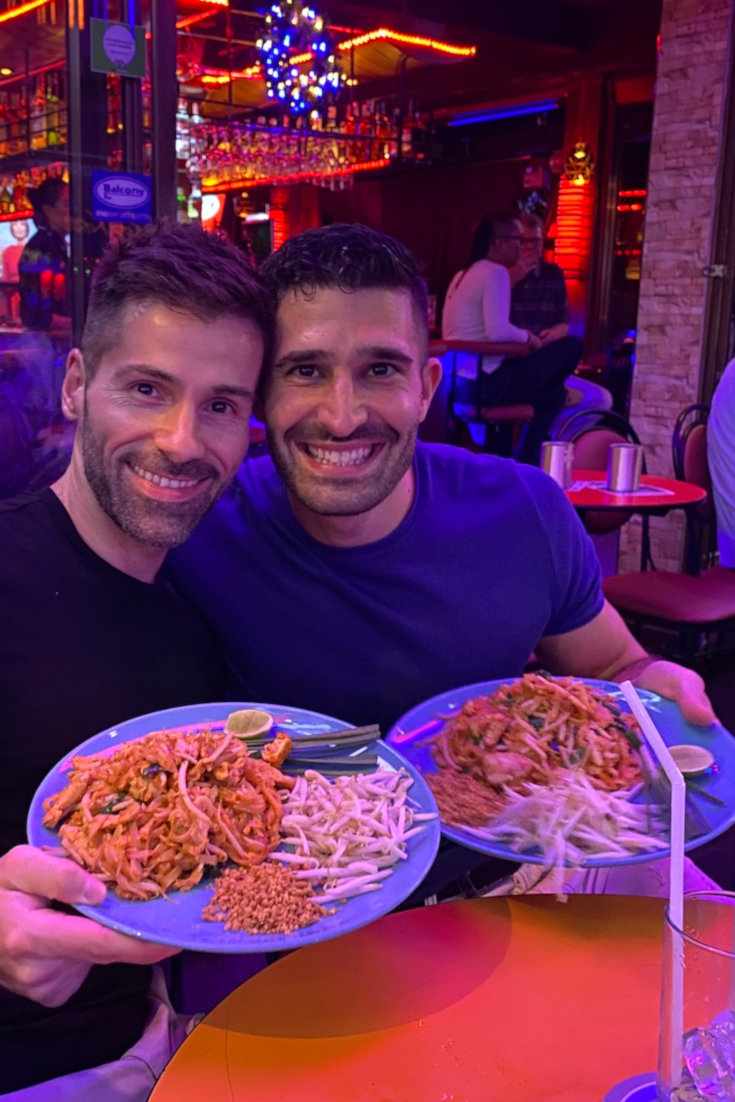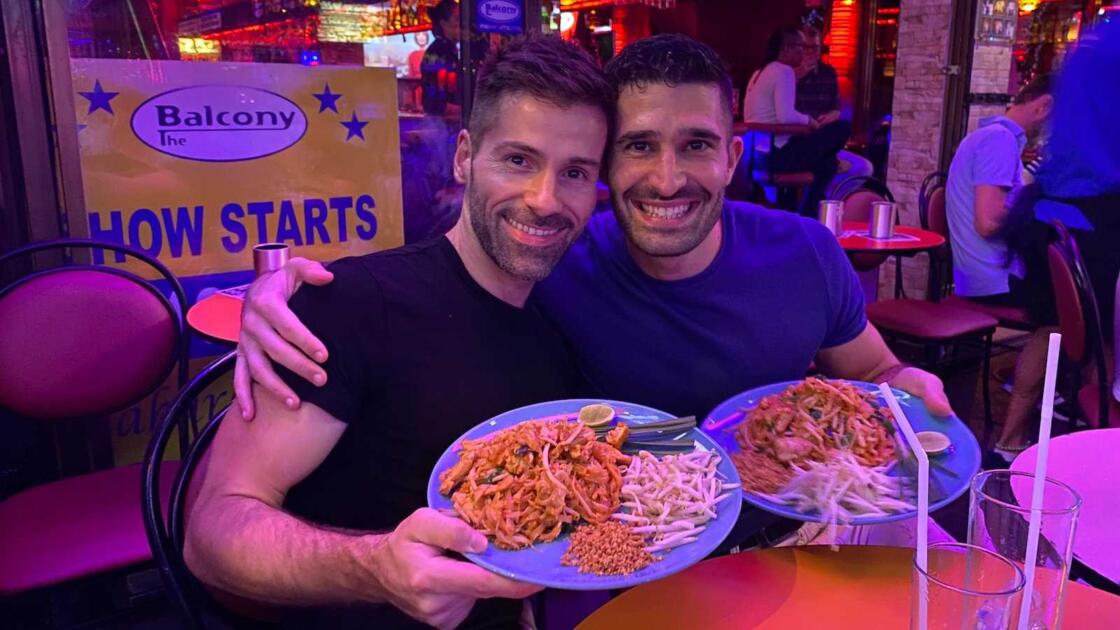These are the best traditional Thai foods you absolutely must try while visiting Thailand.
Our Thailand culinary fairytale began at our local Ting Tong Thai in Acton, West London. As soon as we tasted our first Pad Thai, we were hooked! But the thing with Thai food, it didn’t stop there – from the Som Tam, to the many different curries – yellow, red, green, Massaman, it just kept getting better and better…
Touchdown a few years later in the gay streets of Bangkok and our Thai culinary journey experienced one massive glo-up we’ve not yet recovered from! From the wide range of street food to the many different flavors and spices unique to Southeast Asia, we fell in love. Each region of the country has its distinct offerings.
It’s no reason why Thai food is known the world over. It’s easily one of our favorites. In this article, we summarise our foodie journey through the Land of Smiles, which we hope inspires yours. This is the ultimate Foodie Bucket List of the best traditional Thai foods that you need to try…tick them off as you taste each one:
How did traditional Thai food originate?
Thai food is so diverse with a rich labyrinth of culinary wonders to discover! We found that eating out in Thailand is especially rewarding, particularly at one of the many street food local markets where you can sample lots of different dishes. Today Thai food is one of the most popular cuisines in the world and we can totally understand why!
Obviously, based on location, Thai cuisine has been influenced by the people and food of neighboring countries such as India, Malaysia, Indonesia and China. Buddhist and Muslim communities brought their own influences to bear, as did traders from Portugal, France, England and the Netherlands.
The four main regions of Thailand have also created very distinct differences in cuisine based on available ingredients and geography. Northern Thai cuisine is heavily influenced by Burma and features dishes that are usually herby but not too spicy. Northeastern Thai cuisine is very flavorful, with ingredients like herbs, chillies, garlic and raw veggies dominating the spicy dishes. Central Thai cuisine is often sweeter and less spicy than other regions, owing to Chinese immigrants who settled in Bangkok. And Southern Thai cuisine is home to many spicy curry-based dishes owing to the Malaysian influence.
Wherever you are in Thailand, you will be treated to a smorgasbord of flavor!

1. Pad Thai: the National Dish!
Be honest with us, when you think of Thai food the first thing that probably comes to mind is pad Thai, right? That’s not surprising, as it’s the country’s national dish and you will be able to find it on practically every street corner of Bangkok.
This yummy noodle dish is relatively new, created in the 1930s as part of a political campaign to increase nationalism. Pad Thai is actually more popular with tourists than local Thai people, but the campaign definitely worked to make it a symbol of Thailand.
Pad Thai is made with rice noodles, chicken, beef or tofu, peanuts, a scrambled egg, vegetables and bean sprouts. The distinctive pad Thai sauce that makes this dish so mouthwatering includes tamarind juice, fish sauce, dried shrimp, garlic or shallots, red chili pepper and palm sugar. It seems like a lot of discordant notes but if you’ve never tried pad Thai just trust us, it works!
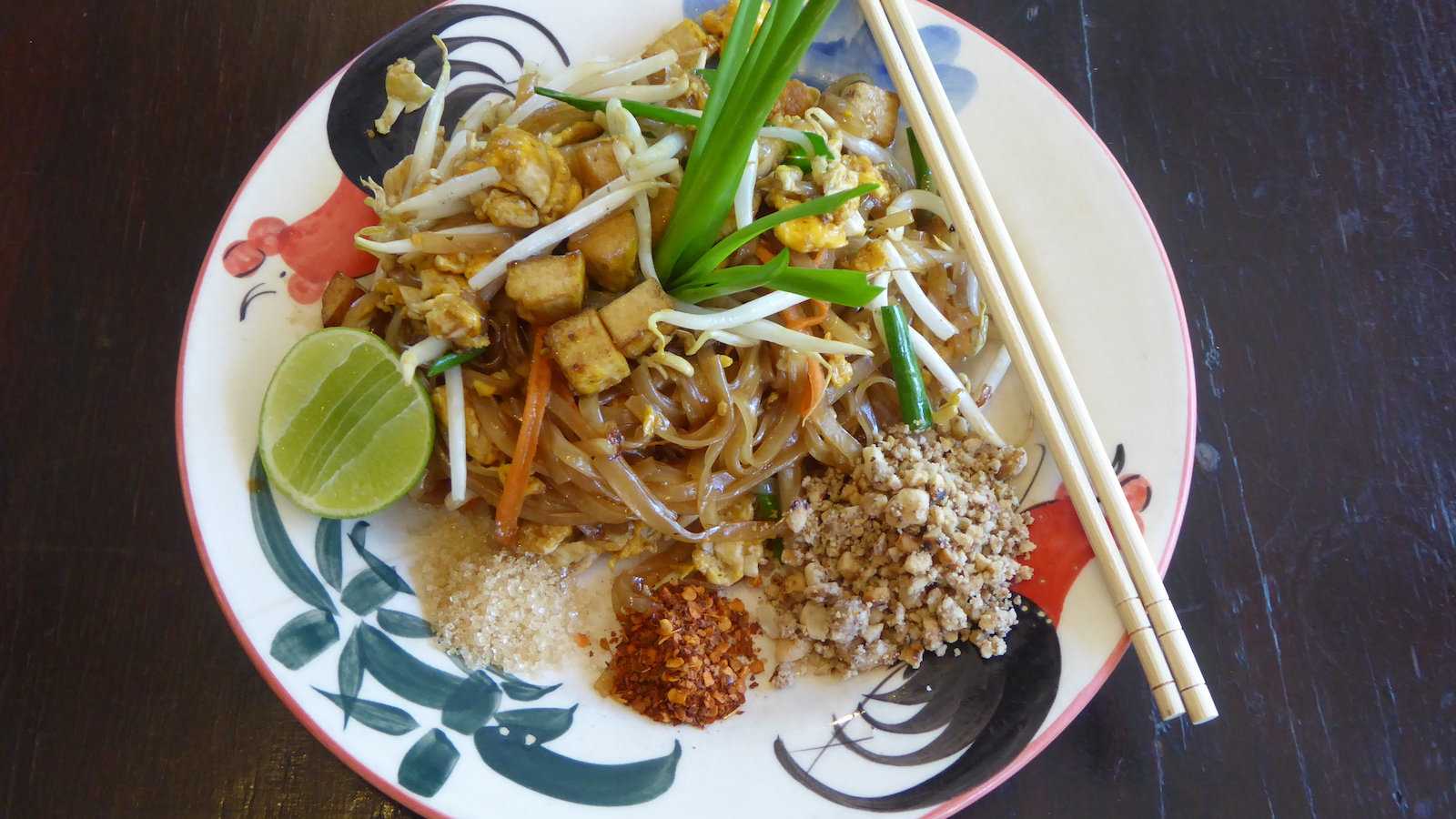
2. Som Tam: spicy papaya salad
If pad Thai is Thailand’s most famous dish then Som Tam is the country’s most famous salad! It’s a simultaneously refreshing and spicy salad made from unripe papaya that can either be a side dish for a full meal or a light meal itself.
Som Tam is made with green papaya, tomatoes, carrots, peanuts, dried shrimp, runner beans, palm sugar, tamarind pulp, fish sauce, lime juice, garlic and plenty of chillies. That means it combines all five tastes of sour, hot, salty, savory and sweet. It can be quite fiery if you’re not used to Thai spice, but you’ll usually be asked how spicy you want it beforehand.
All the ingredients are mixed together with a mortar and pestle to combine them. Although there are sweet elements this is more of a savory and tangy dish, with the crisp papaya adding an element of crunchiness. We could not get enough of some Som Tam!
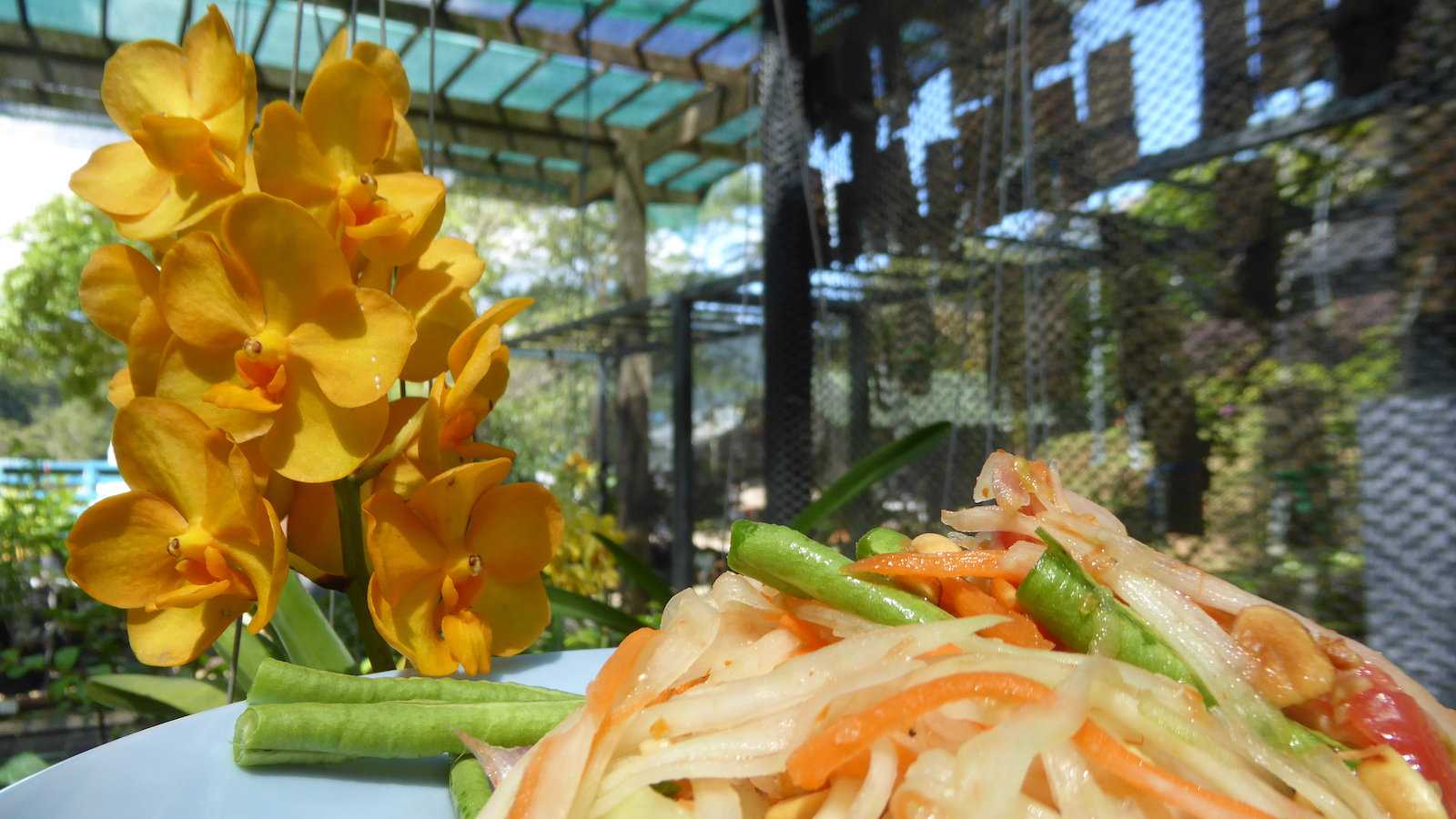
3. Gaeng Daeng: red curry
If RuPaul’s character Ruby Red from TV series AJ and the Queen was a dish, she’d be the bold and spicy colorful Thai red curry, of course – “Ruby is RED hot” remember!
Thai green curry might be slightly more well-known, but that doesn’t mean you should bypass the red curry, otherwise known as gaeng daeng. The red coloring comes from the curry paste which is made from dried red chilli peppers, garlic, shallots, galangal, shrimp paste, salt, kaffir lime leaves, coriander root, coriander seeds, cumin seeds, peppercorns and lemongrass.
To make red curry you cook the red curry paste with coconut milk and a source of protein like chicken, beef, pork, duck or tofu. It looks a bit like a bright red soup and is usually served with rice. We loved this spicy dish and often crave it back at home in Europe when it’s cold and we want some heat to warm up with.
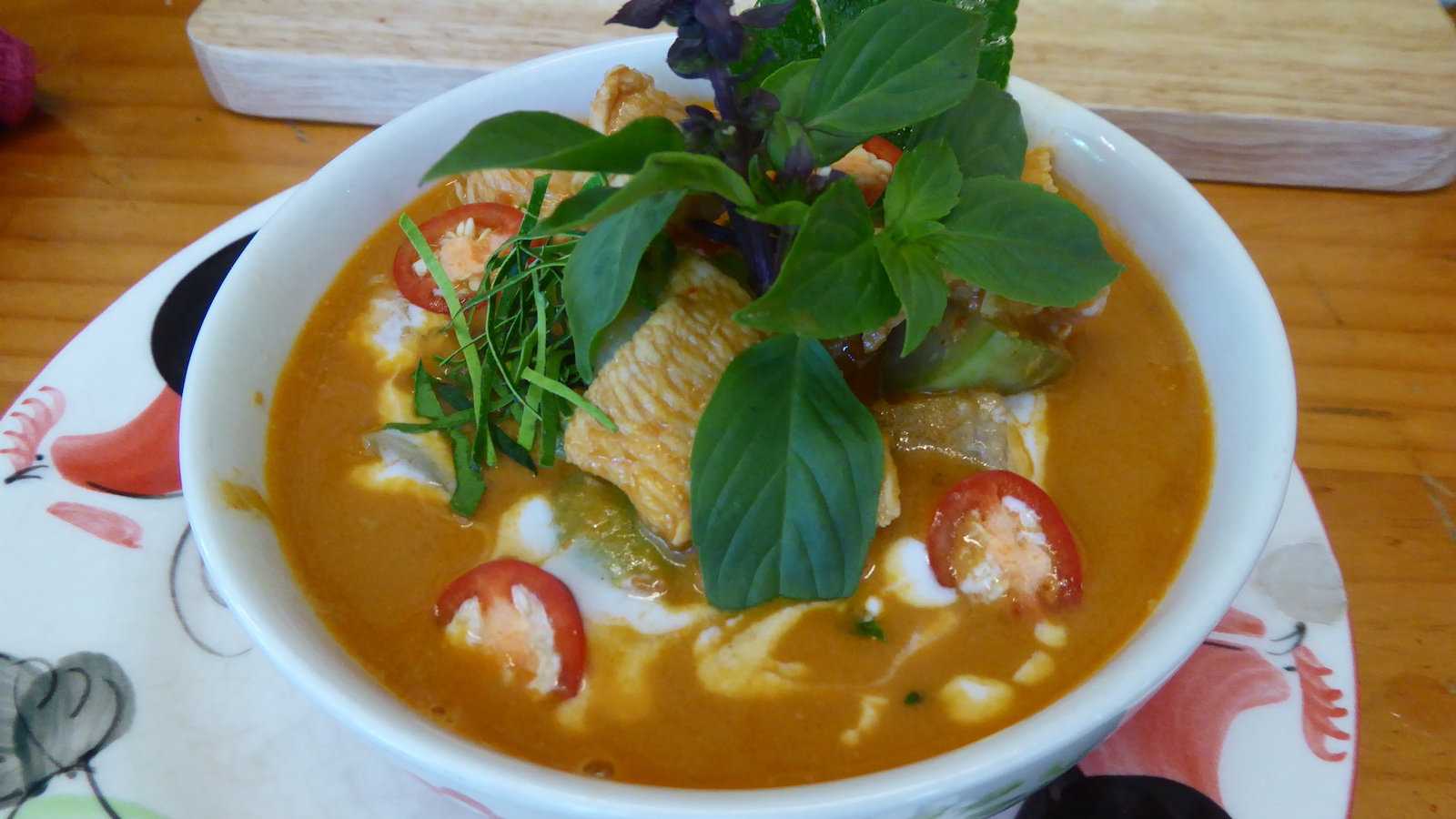
4. Gaeng Keow Wan: green curry
If red means stop to you then you might be ready to go with a Thai green curry. Gaeng keow wan is quite a bit spicier than the red curry, so strap yourselves in for a burst of flavours with this dish!
Originating in central Thailand, Thai green curry gets its signature coloring from the curry paste which is made from green chillies, cilantro, garlic, shallots, lemongrass, galangal, coriander, cumin, shrimp paste and the skin and leaves of kaffir lime. Similarly to the red curry, the paste is then cooked with coconut milk, along with whichever meat or other protein is being used, then eggplant, palm sugar and fish sauce is added.
What we loved about Thai green curry is the balance of salty, sweet, sour and spicy with, of course, the creamy deliciousness of the coconut milk. Serving it with plain steamed rice helps to cool the heat down a little if you need to.
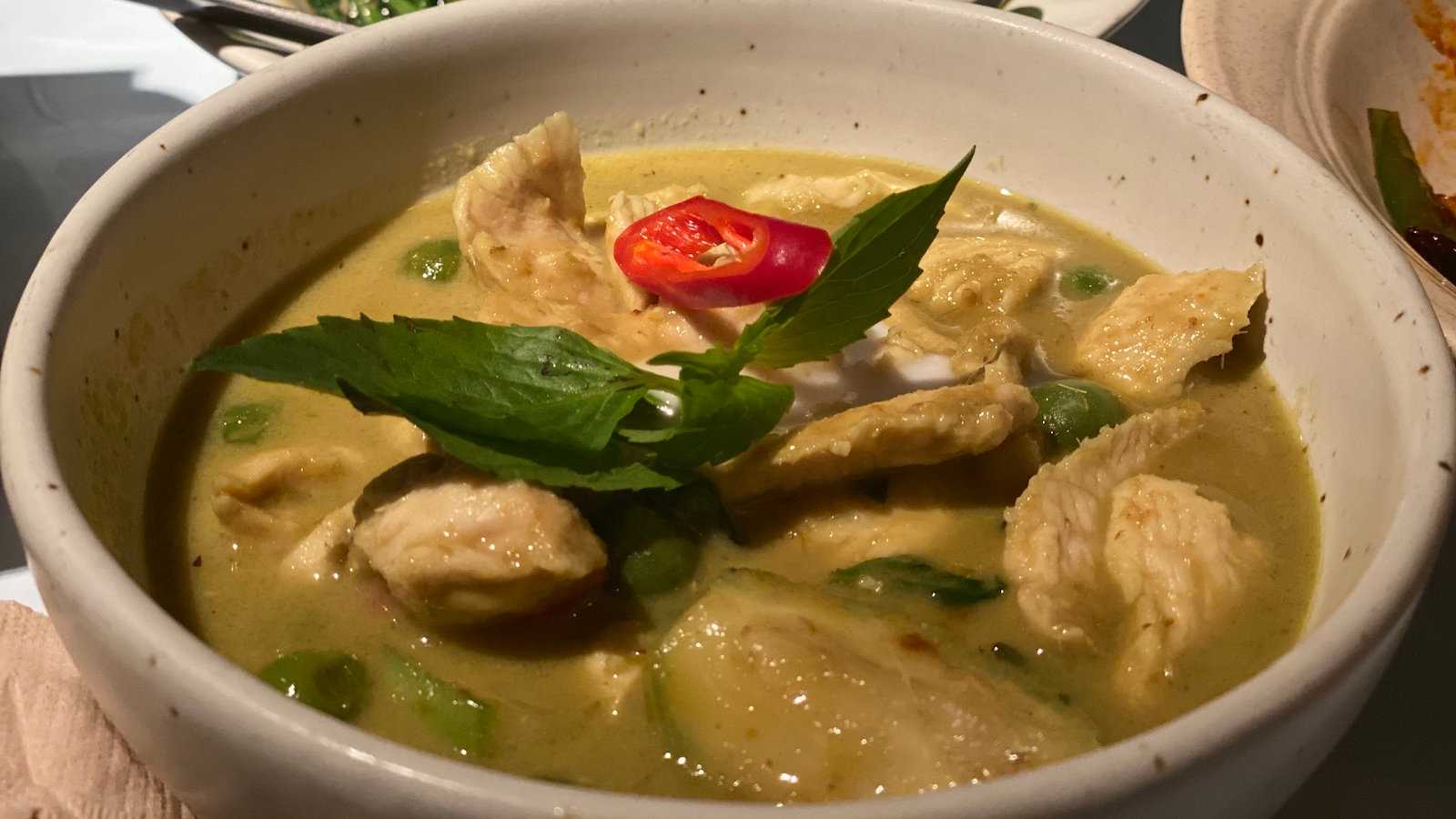
5. Kaeng lueang: yellow curry
Thailand gives us all the colors of a traffic light with their best curries and we are here for it! Rounding out the most colorful trio is kaeng lueang, Thai yellow curry. It’s made with cumin, coriander, turmeric, fenugreek, garlic, salt, bay leaf, lemongrass, cayenne pepper, ginger, mace and cinnamon. If you can’t handle too much spice this one will be perfect for you as it’s generally a bit milder than other Thai curries.
This curry is also good for those who like some carbs as it’s often served with a starchy vegetable like potato. Like most Thai food it’s also eaten with rice or rice noodles to soak up the delectable sauce. Kaen lueang originates from Thailand’s southern coastline, where the flavors have been influenced by both Muslim and Indian cooking.
While we love a good red or green Thai curry, sometimes a bright yellow is just what the doctor ordered for some happiness. It helps that it tastes just as good too!
6. Massaman Curry: rich and mild curry
Of course we can’t talk about Thai cuisine without mentioning the divine Massaman curry! We love this rich curry, which is also relatively mild by Thai standards. Massaman curry is made with flavors that aren’t generally associated with Thai cuisine, mostly because the dish was brought by Muslims who traveled to Thailand from India and the Malay peninsula.
The word Massaman actually means Muslim in an ancient Persian dialect, so Massaman curry is usually made using chicken or beef, not pork. The paste is made from spices that were brought to Thailand such as cardamom, cinnamon, cloves, star anise, cumin, bay leaves, nutmeg and mace, combined with local dried chilli peppers, coriander, lemongrass, galangal, white pepper, shrimp paste, shallots and garlic.
It takes quite a bit of preparation to make Massaman curry, but the results are sooooo worth it. The meat is cooked until it’s so tender it just falls apart and that combined with tender potatoes all covered in the delish sauce… oh em gee!
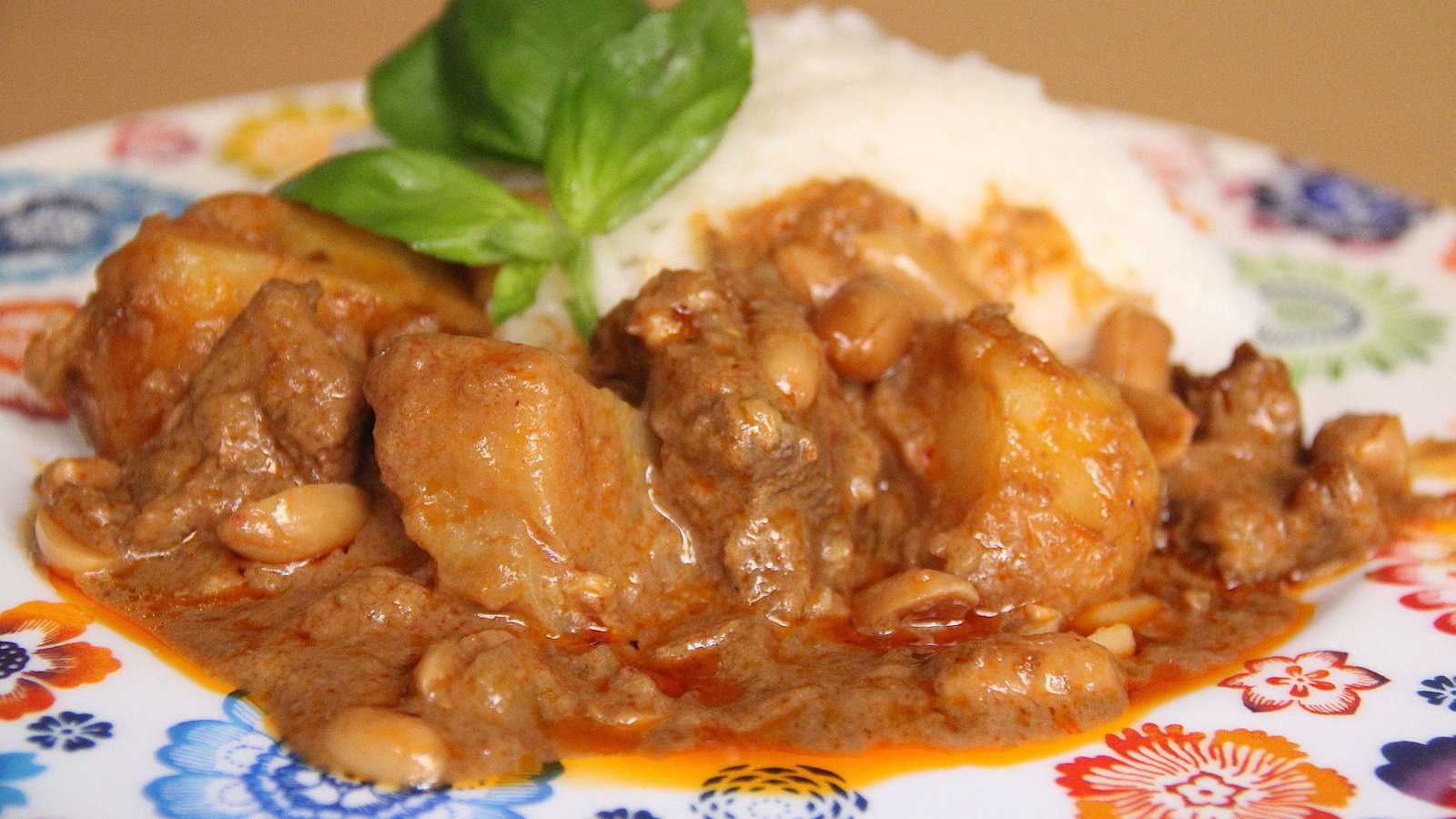
7. Tom Yum Goong: spicy shrimp soup
Another iconic Thai dish which we love is tom yum goong, the spicy shrimp soup from central Thailand that’s very popular. You know something is going to be yummy when it literally has “yum” as part of its name!
Technically, you might see this soup called tom yam or tom yum, which means hot and sour soup. Goong is the Thai word for shrimp and as big seafood lovers you can bet tom yum goong was our favorite variant. The shrimp generally used is actually river shrimp, but don’t be fooled into thinking they are tiny, as Thai giant freshwater prawns are huge.
This soup uses the most quintessential Thai flavorings, like lemongrass, chilli, galangal, kaffir lime leaves, shallots, fresh lime juice and plenty of fish sauce. You can also get a creamier version with coconut milk which is just as good.

8. Tom Kha Gai: chicken in coconut soup
Our other favorite Thai soup has got to be tom kha gai, the creamy, spicy and hot soup that’s made with chicken. Tom kha gai is similar to tom yum goong in its base of galangal, kaffir lime leaves, lemongrass, and chillies, but also includes coconut milk, coriander, mushrooms, chicken, fish sauce and lime juice.
If tom yum goong is a bit too spicy for you then tom kha gai might be a better option as it’s slightly milder. The creaminess of the coconut milk makes all the flavors combine to create a rich and sweet soup that’s very comforting.
The soup comes from Thailand’s northernmost region, where it was influenced by cooks from bordering Laos. It’s also very nutritious AND has some great medicinal benefits especially from the galangal, which can help to aid digestion. Galangal is part of the ginger family but trust us, substituting ginger in the recipe if you’re making tom kha gai at home will not taste as good!

9. Laab: spicy salad
We did tell you that Thailand likes it’s food spicy – even the salads! Laab (or larb) is a spicy minced meat salad that originates in Thailand’s northern region. Laab is also popular in Laos where it is regarded as the unofficial national dish, although the Thai version is different in quite a few ways.
Laab from Thailand is made with minced chicken or pork, roasted rice, lemongrass, mint leaves, and red onion along with the spices of dried toasted chili flakes, toasted ground rice, fish sauce, and lime juice (when we made it we also mixed in some cumin, cloves, long pepper, star anise, prickly ash seeds, and cinnamon). Be warned, laab can have quite a kick, so you may also need to order some glutinous rice to go with it and dilute some of the strong flavors.
Since laab can also be made with the bl00d of the animal, along with bits of liver and other parts, you might also want to specify how you want yours made when ordering. Luckily the Thai people are so lovely that it shouldn’t be a problem!

10. Pak Boong: morning glory
Pak boong is the Thai version of stir-fried morning glory. Morning glory is a semi-aquatic vegetable that’s found throughout southeast Asia and is also called water spinach, river spinach, swamp cabbage, Chinese spinach or Chinese watercress. Basically, it’s very easy to grow in waterways so it’s cheap but also very nutritious and yummy!
Morning glory is sometimes eaten raw in Thailand, or added to stir fries and curries. We really liked it when we could order it as a side dish, pak boong, where the spinach-like vegetable has been stir-fried on its own in soybean paste, soy sauce (or oyster sauce), garlic and chillies.
We loved stir fried morning glory because it’s salty, spicy, sour and crunchy all at the same time. Unfortunately it’s rare to find morning glory in Thai restaurants in the west, so make sure you try some if you see it while in Thailand!
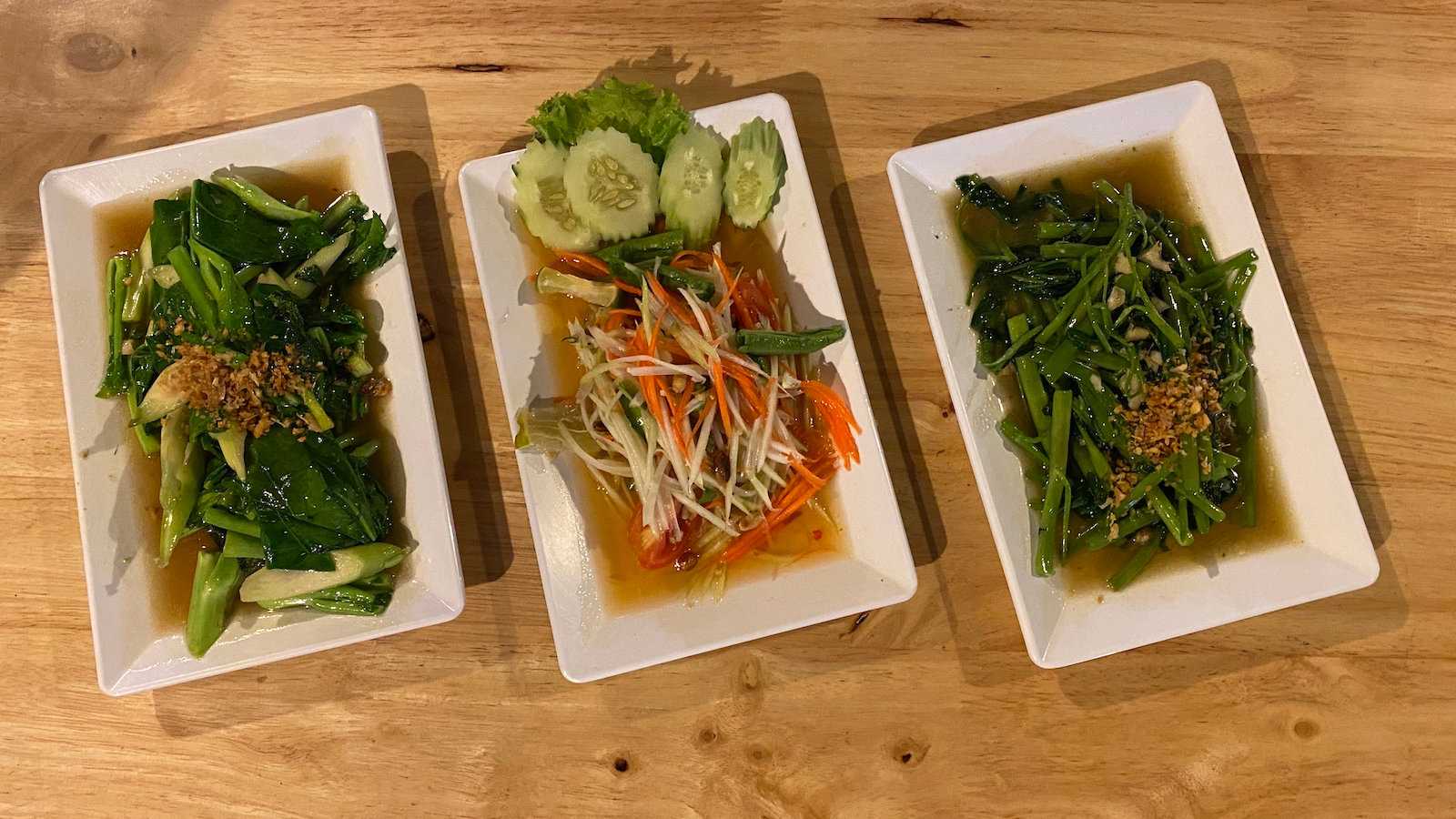
11. Kai Med Ma Muang: chicken with cashew nuts
The Thai name of kai med ma muang might seem like an intimidating mouthful, but pretty much everyone knows of yummy stir-fried chicken with cashew nuts, right? Well, that’s what kai med ma muang is – a mouth-watering mixture of chicken, cashew nuts, soy sauce, honey, onions, chillies, pepper, mushrooms, and whatever other vegetables there are on hand.
This dish is also rather mild by spicy Thai standards, so if you can’t handle too much fire then it’s a safe choice to start with. The scrumptious sweet and salty flavors paired with the crunchy nuts make it a very satisfying meal, plus it’s so quick to make.
Whenever we needed a break from chili we would order this at Thai restaurants or roadside stalls and we even make it ourselves at home sometimes. It might not be quite as fun as watching a lovely local cook it in front of you, but it’s still just as tasty!

12. Khao Niew Ma Muang: mango sticky rice
This is Seby’s favorite dessert! Mango sticky rice is also one of the most popular desserts throughout Thailand, often served during Christmas time as a festive treat. While the mangos in Thailand are most exquisitly sweet and juicy during the mango season (April – June) you will still be able to sample this divine treat at other times.
Mango sticky rice is made by mixing cooked glutinous rice with coconut milk that’s been cooked with sugar and salt. Once the rice has soaked up the milk it’s then put on a plate along with slices of fresh mango and a drizzle of the coconut milk mixture. Some places also add a topping of crispy mung beans for more contrast.
You’ll be able to find mango sticky rice everywhere in Thailand, as it’s popular with locals and tourists alike. We enjoyed trying variations with black rice added in to make the sticky rice purple (like in the picture below) and if you’re really adventurous, you can even have durian with sticky rice as well!
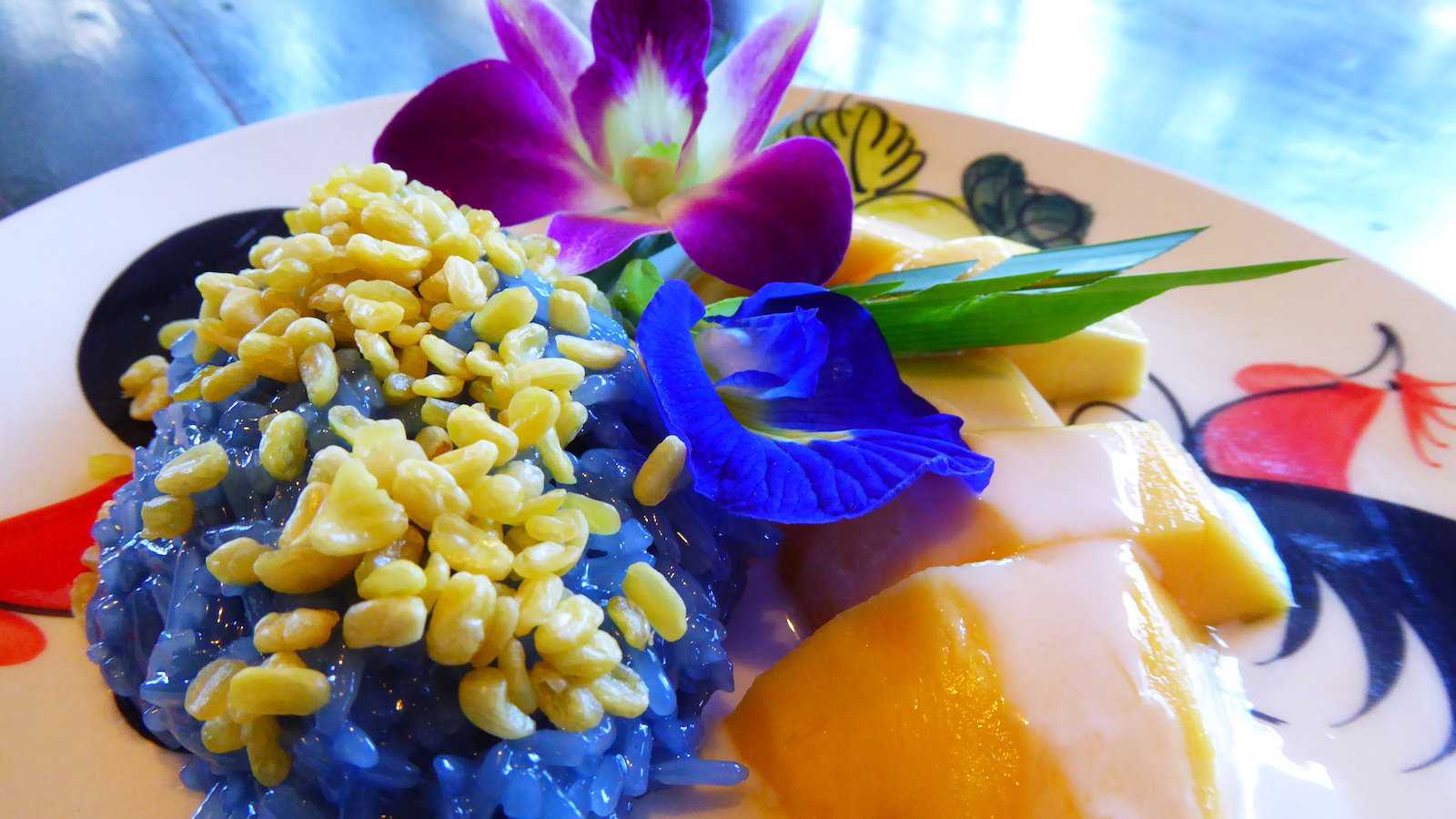
13. Khao Pad: fried rice
Khao pad is another ubiquitous dish you’ll be able to find all over Thailand, as it’s the Thai version of fried rice. Thai fried rice is different from the well-known Chinese variety in a number of ways though. Firstly, Thais use jasmine rice rather than white rice. Secondly, while Chinese fried rice uses soy sauce as the main condiment, in Thailand it’s prik nam pla – a spicy fish sauce.
Thailand’s fried rice generally uses fewer vegetables than Chinese fried rice as well, instead opting to serve the rice with slices of fresh cucumber. Sometimes there may be meat or prawns plus onion and egg cooked with the rice.
One of the best things about khao pad is that it’s perfect for a light meal or snack, but can also be one of many side dishes with a complete meal. We had it from street food stalls and at restaurants, especially when we craved something not too fancy or spicy!
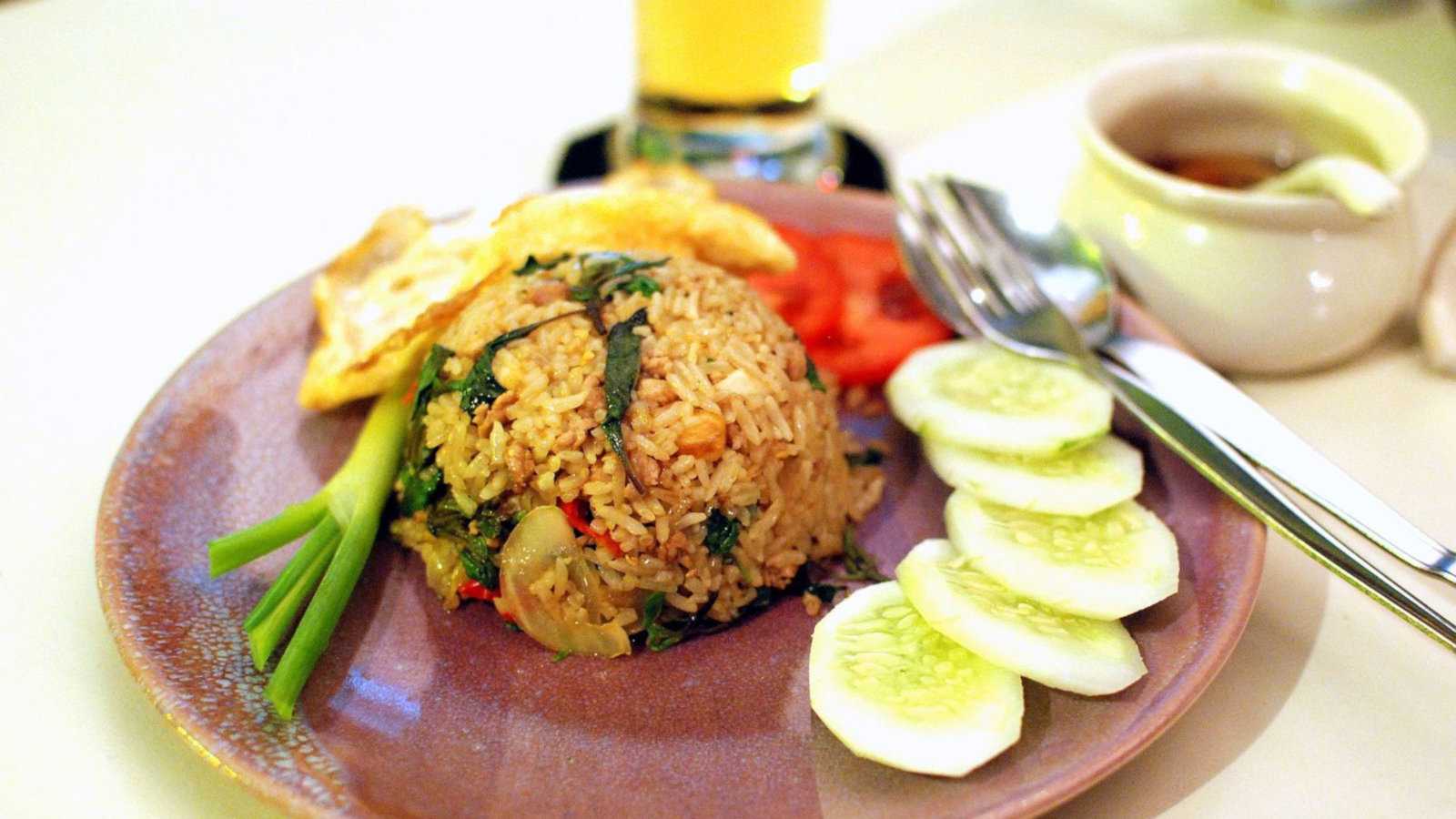
14. Moo Tod Kratiem: deep-fried pork with garlic and pepper
Clearly, Thai cows don’t say moo, because moo on the menu in Thailand means pork! Moo tod kratiem was our favorite pork dish in the country, a delicious deep-fried version that’s surprisingly simple, just pork fried with garlic and pepper.
Thai children especially love moo tod kratiem, but so do foreigners who need a break from the spicy stuff. This easy and tempting dish is usually served as a side dish for a curry, on its own as a snack or with rice. It used to be more often found in Thai homes, rather than restaurants, but has gained popularity over the years so you will be able to find it all over the place.
Moo tod kratiem is also one of those snacks eaten in Thailand as an accompaniment to some beers, along with nuts or other small bites. Or you might be able to get some from a street food stall with rice and a fried egg.
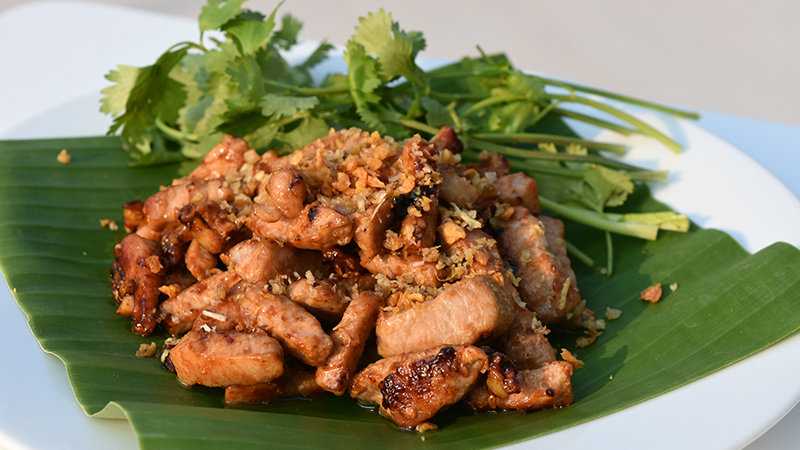
15. Kao Jeow: Thai-style omelette
Kao (or kai) jeow is easily recognizable as an omelette, but hold that thought as a Thai omelette is certainly not that similar to the western versions. One of the main differences is that Thai omelettes are cooked with a lot of oil which make the outside quite crispy while the inside remains fluffy. The other main point of difference is the use of fish sauce to flavor it.
You can order Thai-style omelettes at nearly every street food stall you find, and there are lots of variations to try. You can have your omelette with meat and/or vegetables cooked inside it, or just served on rice with some sweet chilli sauce. It’s also a popular Thai cuisine around Christmas time.
Kao jeow is generally a breakfast food in Thailand, along with the similarly savory jok (see the next entry). But hey, feel free to have breakfast for dinner if you’d rather eat kao jeow as a main meal!
16. Jok: Thai rice porridge
Jok is the Thai name given to rice congee, a kind of rice porridge that’s popular for breakfast and no, we’re not joking, although the name is pronounced like joke! Rice porridges are common in many Asian countries (read about chao in our guide to Vietnamese foods), it’s basically like oatmeal except usually served with savory elements rather than sweet.
Thai jok is made by boiling rice in water until it’s so soft that it starts to break down and becomes like a porridge in consistency. It is then served (most often as breakfast) with added toppings like an egg, minced pork or beef, chopped spring onions, fried garlic, slivered ginger, and spicy pickles.
A savory porridge for breakfast might sound weird if you’re a westerner used to sweet cereals or jam on toast, but it’s definitely something that grows on you. Make sure you give it a try when you’re in Thailand!
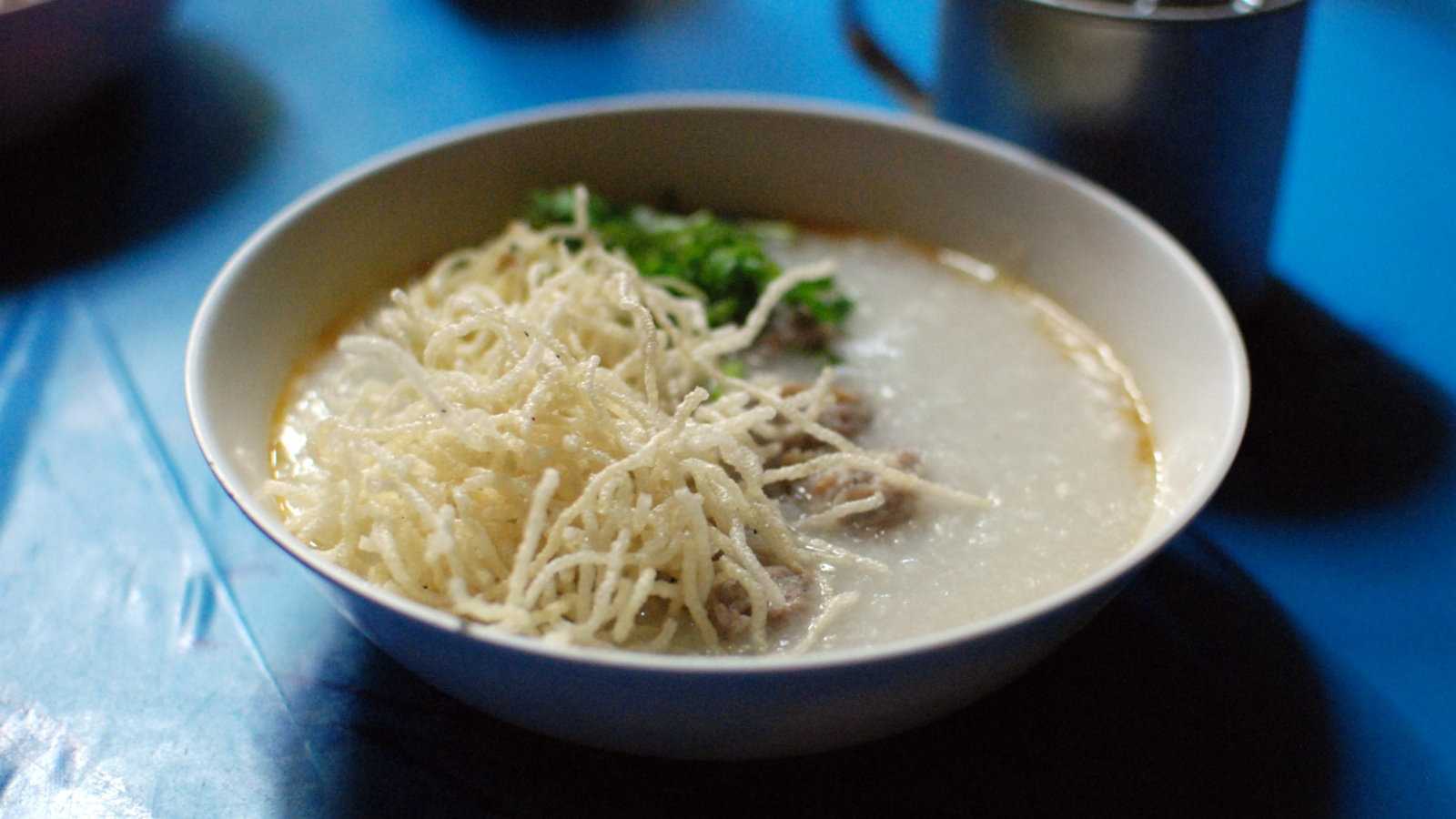
17. Sai ua: Chiang Mai sausage
What can we say, we do love a bit of sausage! But get your minds out of the gutter because we’re talking about sai ua, a tasty spiced sausage made from pork that originated in Thailand’s northern regions. They’re stuffed with minced pork, lemongrass, kaffir lime, chilli, garlic, ginger and a red curry paste.
The result is incredibly fiery, so prepare yourself if you are looking to try one of these red-hot bangers. Even Gordon Ramsay coughed a little in surprise when he first tried sai ua! While this dish originated in Thailand’s north and is easy to find in and around Chiang Mai, it has also become very popular across the country.
If you see a sai ua stall with a line, make sure you hop in because that means it’s going to be one of the really good recipes. Sometimes you’ll be able to buy some sausage links on their own but at other establishments it can be served with rice or as the starter for a meal.
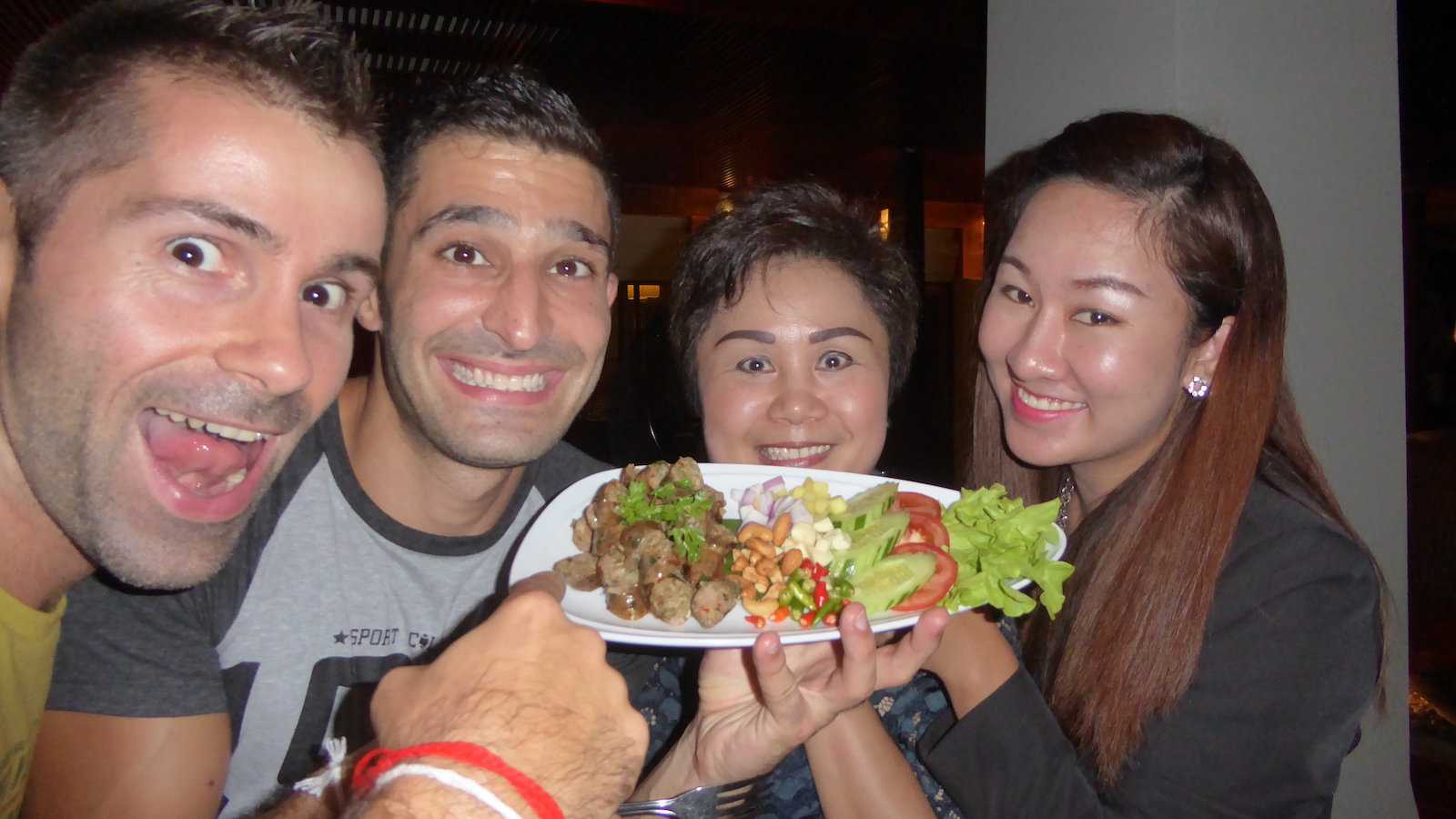
18. Khao neeo dang: red sticky rice
Khao neeo dang is a pretty special version of the sticky rice we mentioned earlier, that is served as a unique traditional wedding dish in Bangkok. However, this sticky rice dish is rather different and a lot more complicated than the street food version!
It takes a lot of time to make khao neeo dang, as the sticky rice is cooked with alum powder for five hours before being rinsed and steamed. It’s then mixed with hot sugar caramel and coconut milk before being poured into a tray to cool. Once cooled, it’s shaped into a heart and served with sesame seeds on top.
Since it needs a lot of time and usually many people to make this large dish, it symbolizes unity between the families of a bride and groom. While you might be able to find this sweet sticky rice in shops, you’ll need to get yourself invited to a traditional Bangkok wedding to see the true masterpiece!
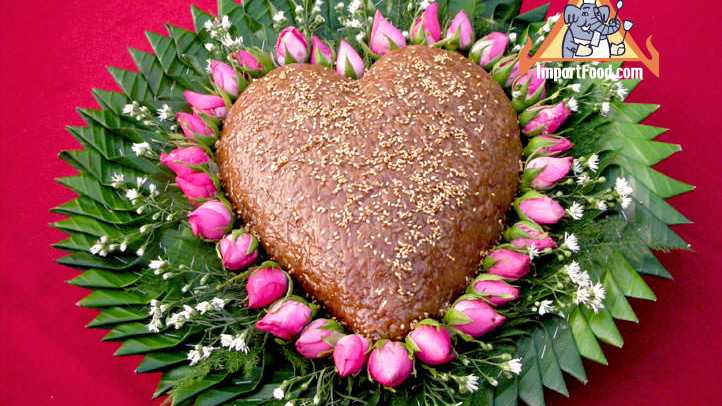
19. Khanom Buang: Thai crispy pancakes
If kao jeow is a Thai omelette then khanom buang is the Thai version of a sweet crepe. It’s a popular traditional Thai dessert, sometimes called crispy pancakes and looking a little bit like a taco. Like so many of Thailand’s best foods, you will find khanom buang at street food stalls, in malls and even at floating markets.
Khanom buang is made with a rice flour pancake that’s then filled with a rich meringue cream and topped with a candied duck egg yolk, or coconut or even salty and savory toppings. The recipe actually originated in the Ayutthaya period over 600 years ago.
Make sure to stop and try these sweet taco-looking treats if you’re ever wandering through a Thai market and smell delicious pancakes cooking then see these cute snacks. Even if you don’t fancy braving one with scallions, the sweet versions are a fluffy delight!
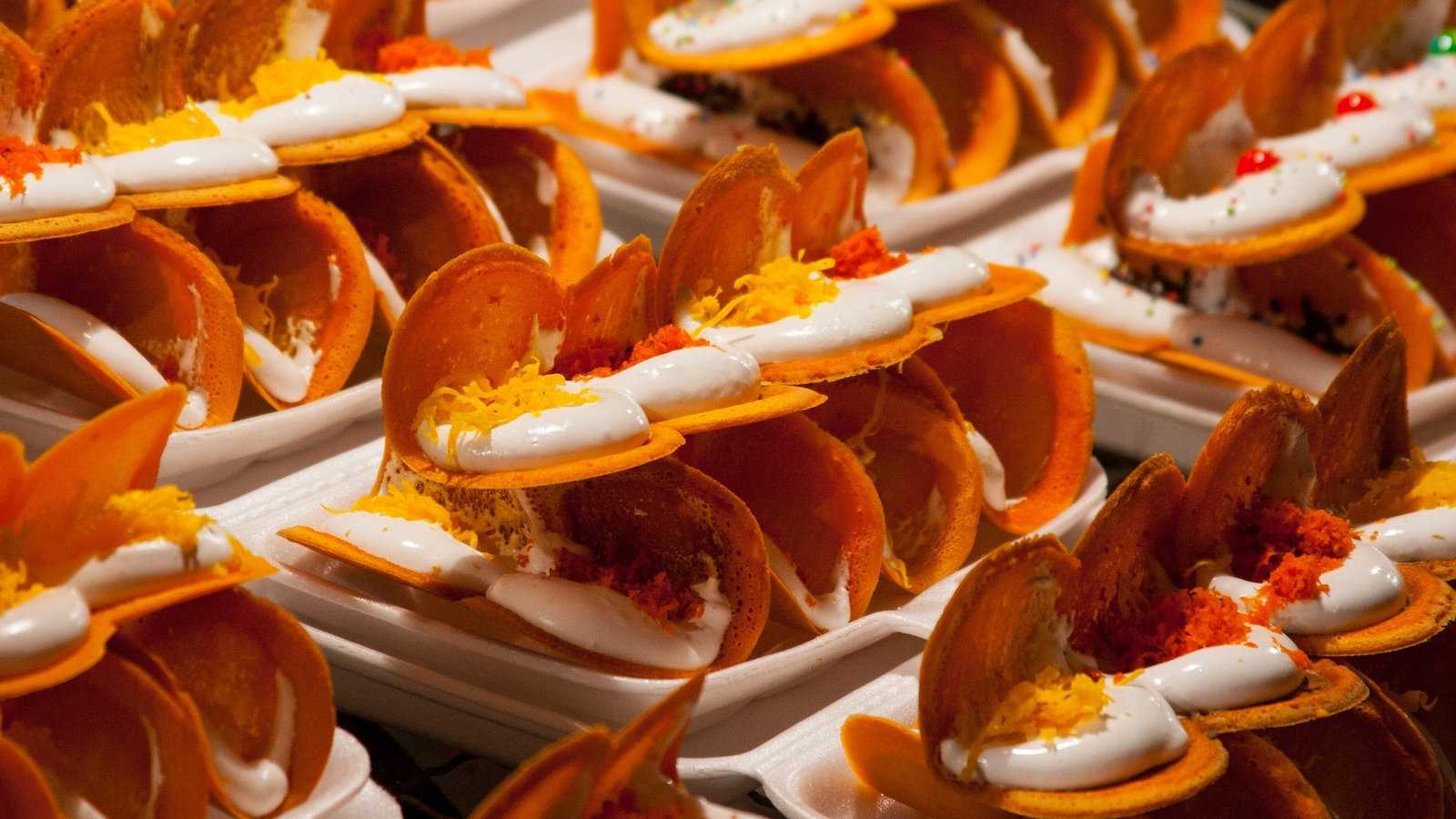
20. Kao Tom Mud: Thai Sticky Rice Cake
Our other favorite traditional Thai dessert that’s popular throughout the country is kao tom mud. These little parcels of lusciousness are so simple yet so satisfying! They are made with just four ingredients: sticky rice, coconut milk, sugar and bananas.
Kao tom mud is made by putting a piece of banana inside sticky rice that’s been cooked with coconut milk and sugar, wrapping the whole thing in a banana leaf then steaming the little parcel. When you buy one from a stall or shop you then unwrap the green leaves to find a delectable little morsel of warm coconut and banana flavors.
Freshly made and warm kao tom mud is the best, but you can also eat them cold if, for example, you try your hand making them at home and then store them in the refrigerator. You may also find varieties with black beans dotted amongst the banana and rice.
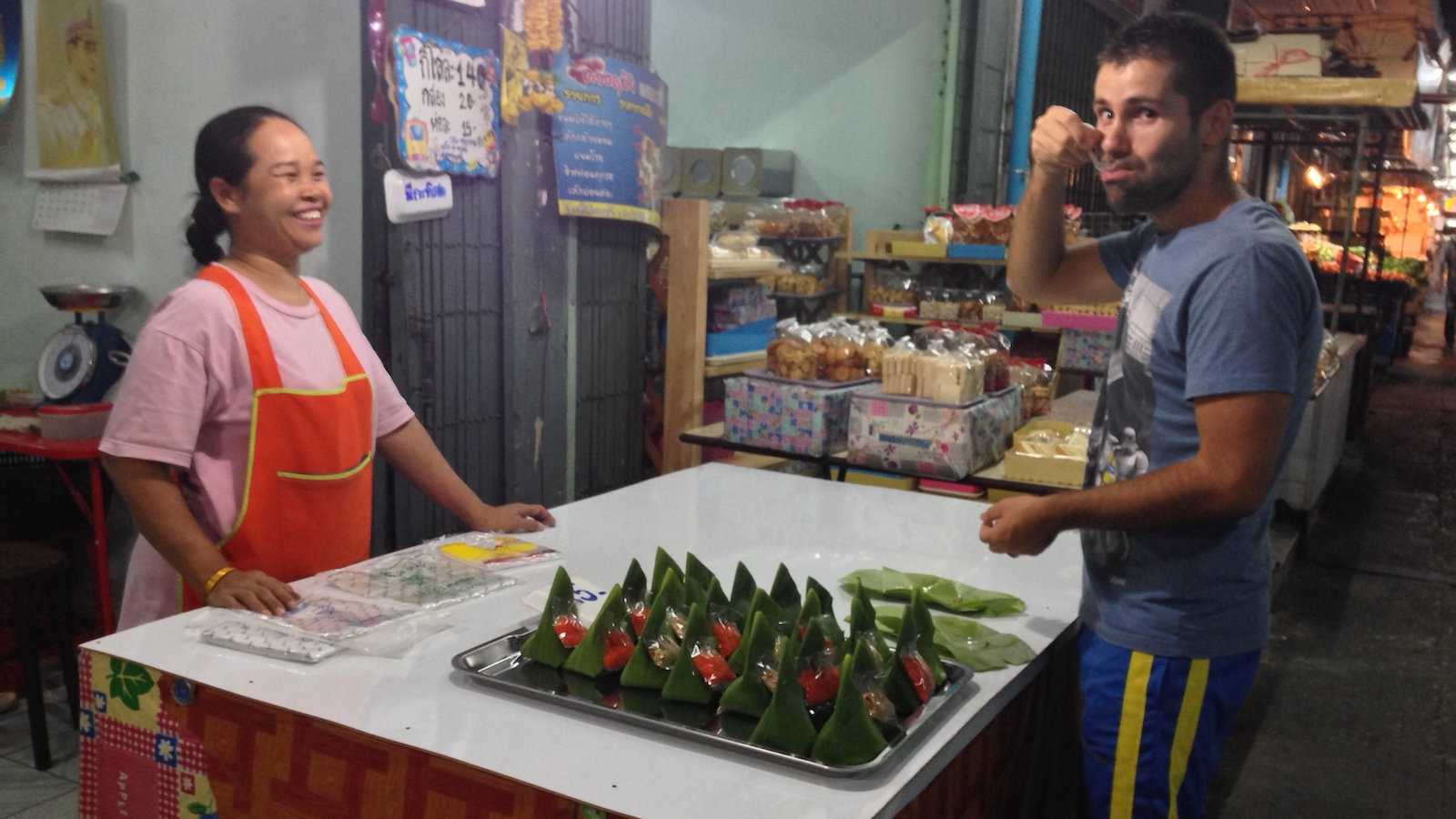
For more inspiration:
- Make sure you also check out our gay country guide to Thailand
- These are the best gay islands in Thailand for a tropical getaway
- Read our guide to renting pocket WiFi in Thailand to ensure you can get online
- Find out what it’s like to grow up gay in Thailand in our local interview
- These are the best gay hotels in Bangkok if you’re heading to the capital
- And make sure you check out our guide to the gay neighborhood of Bangkok while you’re there!
